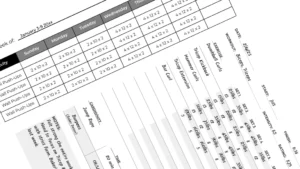Introduction
“9 pounds in one week…this is freaking amazing!” That was my thought when I weighed in this morning and noticed that I had dropped 9 pounds since this time last week. So from the title you can probably get a pretty good indication as to what I’m attributing as to the reason.
First of all, let me state that I don’t know if this is typical, just relating my experience with it so far. I’m sure some of the loss can be attributed to water weight. We’ve experienced record breaking temperatures here as it hit 104 yesterday and I was out in it for about 4 hours. But I also know that some of the loss is body fat as well due to measurements. My waist is down about .5″ and using the Accu-Measure skinfold caliper, I’m down about 1.6% body fat for the week as well!
Calorie Cycling
So how does calorie cycling work? This is very different from your typical diet, which generally you would determine your daily caloric needs, then create a calorie deficit. So, let’s say you want to lose a pound of fat a week and your daily caloric needs are 2,000 calories per day. Since 1 lb of body fat is roughly 3,500 calories, you would need to eat 10,500 calories per week (14,000 – 3,500 = 10,500) . You would divide 10,500 by 7 days and arrive at 1,500 calories a day. As anyone who has been on a typical diet before can attest, this works great until you hit the dreaded plateau.
There are a couple reasons for the plateau: homeostasis and catabolism. Homeostasis is the body’s ability to seek out internal stability. Eventually your body realizes that it’s been at a deficit and interprets the fewer calories as a warning sign that food may be getting scarce, this reaction can be attributed to our genes programmed for survival like when our ancestors went through famines. As a defense mechanism, your body starts to secrete hormones that affects your metabolism, specifically how much energy your body burns.
The second issue is catabolism, which is a type of destructive metabolism where muscle/lean tissue is broken down to close the gap for the calorie deficit. This is why you could show a weight reduction on the scales, but instead of just fat, its also some of your lean tissue and muscle as well. Not the sort of thing we’re after here.
Enter calorie cycling. This is where you trick the body by constantly adjusting the number of calories consumed per day so it doesn’t think its on a diet at all. Let’s go back to our example of a person who needs to consume about 10,500 calories per week to lose 1 pound of fat per week. So with calorie cycling it might look like this:
- Monday – 1,500
- Tuesday – 1,100
- Wednesday – 1,900
- Thursday – 1,500
- Friday – 1,300
- Saturday – 1,700
- Sunday – 1,500
The total calories consumed in this example is still 10,500 calories, so you’ve created the deficit that you wanted. But by changing the amount of calories you eat on a daily basis, the theory is that you trick the body because it doesn’t think food is scarce and thus you are able to ward off homeostasis and catabolism.
The question is not whether or not this method burns fat; if you have the discipline to follow through with it and keep accurate records of what you eat, it will work. The real question is if it really does ramp up the metabolism as it claims by constantly cycling the number of calories so that the body doesn’t react negatively and sabotage our efforts.
There is not a whole lot of clinical research in this area, but there is plenty of anecdotal support by those who tout their results using calorie cycling. I’m still reserved on my verdict as its only been one week for me, but I don’t expect to drop 9 pounds every week either. Typical diets aim to burn 1 – 2 pounds of fat per week and that’s the rate many nutritional experts advise. But even if calorie cycling can help me achieve 3 – 4 pounds per week, I’ll be quite happy as I’ve doubled that amount.
Tabata Method
The second key to this rapid loss, IMHO, is using Tabata Method training. It’s based on HIIT methodology (High-intensity Interval Training) where you perform 8 rounds of ultra intense exercise for 20 seconds followed by 10 seconds of rest. This is in direct contrast to how we’ve been told to exercise for aerobic conditioning. Most aerobic fitness advice would advise you to go for long duration of time, such as an hour or more, at a slow to moderate pace. Well, if you’ve tried this, you probably realized how inefficient it really is. I mean how many marathon runners do you know or have you seen with good looking physiques? I can’t say I’ve seen any…they usually are anemic-looking and pardon the pun, “run” down.
The truth to why slow aerobic training is terribly inefficient when it comes to losing weight and burning fat has to do with a 4-letter acronym: EPOC.
EPOC stands for Excess Post-Exercise Oxygen Consumption and covers the amount of calories you burn after you are done exercising. With slow aerobic training, you only burn calories while working out, once you’re finished that’s it. But with HIIT exercises your body continues to burn calories for up to 2 days later. This is why you might initially burn more calories with slow aerobic training, but HIIT is going to continue burning long after your workout, making it so much more efficient.
Now I know HIIT works and it worked very well for me once before. The best shape of my life came after doing Sprint 8’s, where you sprint 75 yards eight times. After each sprint, you rest for about 90 seconds and do it again; each time gradually increasing the intensity until your last sprint is at 100% effort. Like I said, this worked really well for me, but I didn’t want to jump right back into it and risk developing shin splints.
With Tabata, you can do exercises such as jumping jacks, mountain climbers, burpees, etc. This seemed like a perfect way to get more conditioned before introducing sprinting back into my regimen.
Resources
One site I’ve found extremely helpful in performing these timed intervals can be found here: http://www.speedbagforum.com/timer. This allows me to program how long I want each round to last and the rest duration. It’s been great to allow me to focus on working out and not have to keep track of the time myself. If you prefer to work outdoors or don’t have access to a computer while working out, the Gym Boss is a cool little device that is small enough to take with you and perfect for programming/customizing your workout. You can find out more about it here: http://www.gymboss.com/
I’ll post my progress on this on a weekly basis so check back if you’re interested in seeing how this turns out. If you’ve had any experiences with either of these methods (positive or negative) let me know how it worked out for you.
Until next time…





Pingback: The Best HIIT App? - Skreamin' Skull